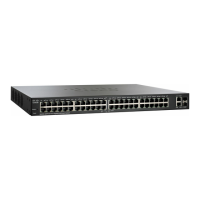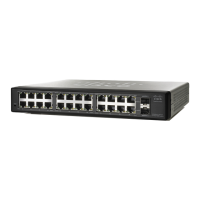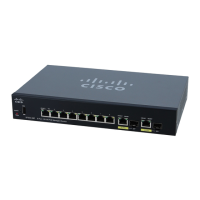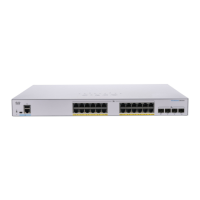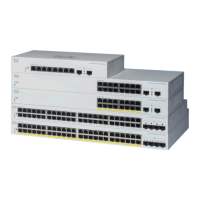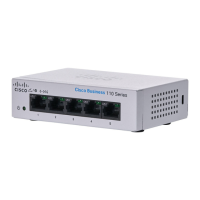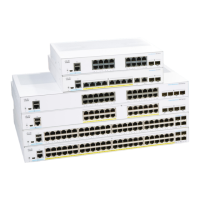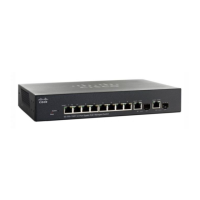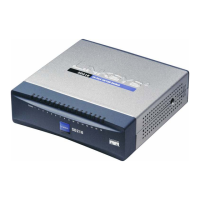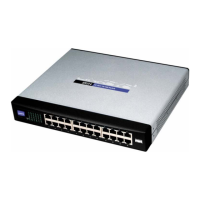Do you have a question about the Cisco Small Business 200 and is the answer not in the manual?
Introduction to accessing and navigating the web-based configuration utility.
Overview of links on the Getting Started page for quick device configuration.
Description of the web-based configuration utility's window features and application links.
Displaying traffic statistics per port and setting the refresh rate for Ethernet interfaces.
Configuration and viewing of RMON statistics for network monitoring.
Enabling/disabling logging and selecting event severity levels for system logs.
Defining remote SYSLOG servers for receiving log messages.
Description of system files, including configuration, firmware, and boot code.
Process for upgrading or backing up firmware, boot code, or language files.
Enabling and configuring automatic device configuration via DHCP.
Information on different switch models, their ports, and PoE capabilities.
Displaying device status, hardware, firmware, and general PoE status.
Procedure for rebooting the device, including scheduling and factory defaults.
Methods for setting system time, including manual, PC, and SNTP server.
Selecting the system time source and configuring time zone and DST settings.
Performing cable tests on copper ports using Virtual Cable Tester (VCT).
Setting up port mirroring to copy network packets to a monitoring connection.
Enabling and configuring Bonjour Discovery protocol for device advertising.
Overview of Link Layer Discovery Protocol (LLDP) and Cisco Discovery Protocol (CDP).
Detailed steps for configuring LLDP, including global parameters and port settings.
Detailed steps for configuring CDP, including global parameters and interface settings.
Actions for configuring ports, including settings, aggregation, and Green Ethernet.
Steps for configuring Link Aggregation Control Protocol (LACP) and LAGs.
Description and configuration of Green Ethernet features for power saving.
Introduction to the Smartport feature for saving and sharing interface configurations.
Enabling and configuring Auto Smartport for automatic interface configuration.
Common tasks for setting up Smartport and Auto Smartport features.
Description of Power over Ethernet (PoE) features and operation.
Setting PoE mode (Port Limit/Class Limit) and configuring PoE traps.
Description of VLANs, their IDs, tagging, and roles.
Procedure for creating single or a range of VLANs on the device.
Configuration of Voice VLANs for voice traffic prioritization.
Overview of Spanning Tree Protocol (STP) versions and their functions.
Enabling STP/RSTP and configuring global parameters like priority and BPDU handling.
Configuring Rapid Spanning Tree Protocol (RSTP) settings per port.
Explanation of static and dynamic MAC addresses and their storage.
Assigning static MAC addresses to specific interfaces and VLANs.
Configuring aging time and querying dynamic MAC addresses.
Description of multicast forwarding and its benefits for network efficiency.
Enabling IGMP Snooping for selective multicast forwarding on static VLANs.
Enabling and configuring MLD snooping for IPv6 multicast traffic.
Managing IPv4 addresses, interfaces, and ARP table settings.
Defining IPv6 global parameters and DHCPv6 client settings.
Configuring DNS settings, search lists, and host mappings.
Creating and managing user accounts, including password complexity.
Configuring the device as a RADIUS client for centralized authentication.
Assigning authentication methods for managing device access.
Creating and managing access profiles to control user access.
Configuring the Secure Socket Layer (SSL) feature for HTTPS sessions.
Enabling and configuring storm protection to limit traffic rates.
Limiting port access to users with specific MAC addresses.
Enabling and configuring port-based network access control (802.1X).
Implementing measures to resist Denial of Service (DoS) attacks.
Securely exchanging data over a network using SSH and SCP protocols.
Configuring authentication methods, usernames, and passwords for SSH clients.
Performing common tasks for SSH client configuration and data transfer.
Defining read permissions and default read modes for sensitive data access.
Configuring parameters that define and control the SSD environment.
Management of configuration files, including running, startup, and backup files.
Overview of QoS features for prioritizing network traffic.
Enabling QoS, selecting trust modes, and assigning priorities.
Configuring egress queues, scheduling methods, and bandwidth allocation.
Overview of SNMP versions (v1, v2, v3) and configuration workflow.
Defining the SNMP Engine ID for unique identification of SNMPv3 entities.
Creating and editing SNMP views for managing MIB subtrees.
Defining SNMP groups with associated security levels and views.
Creating and managing SNMP users, associating them with groups and engine IDs.
Defining SNMP communities for access rights in SNMPv1 and v2.
Configuring SNMP notification filters and Object IDs (OIDs).
Introduction to accessing and navigating the web-based configuration utility.
Overview of links on the Getting Started page for quick device configuration.
Description of the web-based configuration utility's window features and application links.
Displaying traffic statistics per port and setting the refresh rate for Ethernet interfaces.
Configuration and viewing of RMON statistics for network monitoring.
Enabling/disabling logging and selecting event severity levels for system logs.
Defining remote SYSLOG servers for receiving log messages.
Description of system files, including configuration, firmware, and boot code.
Process for upgrading or backing up firmware, boot code, or language files.
Enabling and configuring automatic device configuration via DHCP.
Information on different switch models, their ports, and PoE capabilities.
Displaying device status, hardware, firmware, and general PoE status.
Procedure for rebooting the device, including scheduling and factory defaults.
Methods for setting system time, including manual, PC, and SNTP server.
Selecting the system time source and configuring time zone and DST settings.
Performing cable tests on copper ports using Virtual Cable Tester (VCT).
Setting up port mirroring to copy network packets to a monitoring connection.
Enabling and configuring Bonjour Discovery protocol for device advertising.
Overview of Link Layer Discovery Protocol (LLDP) and Cisco Discovery Protocol (CDP).
Detailed steps for configuring LLDP, including global parameters and port settings.
Detailed steps for configuring CDP, including global parameters and interface settings.
Actions for configuring ports, including settings, aggregation, and Green Ethernet.
Steps for configuring Link Aggregation Control Protocol (LACP) and LAGs.
Description and configuration of Green Ethernet features for power saving.
Introduction to the Smartport feature for saving and sharing interface configurations.
Enabling and configuring Auto Smartport for automatic interface configuration.
Common tasks for setting up Smartport and Auto Smartport features.
Description of Power over Ethernet (PoE) features and operation.
Setting PoE mode (Port Limit/Class Limit) and configuring PoE traps.
Description of VLANs, their IDs, tagging, and roles.
Procedure for creating single or a range of VLANs on the device.
Configuration of Voice VLANs for voice traffic prioritization.
Overview of Spanning Tree Protocol (STP) versions and their functions.
Enabling STP/RSTP and configuring global parameters like priority and BPDU handling.
Configuring Rapid Spanning Tree Protocol (RSTP) settings per port.
Explanation of static and dynamic MAC addresses and their storage.
Assigning static MAC addresses to specific interfaces and VLANs.
Configuring aging time and querying dynamic MAC addresses.
Description of multicast forwarding and its benefits for network efficiency.
Enabling IGMP Snooping for selective multicast forwarding on static VLANs.
Enabling and configuring MLD snooping for IPv6 multicast traffic.
Managing IPv4 addresses, interfaces, and ARP table settings.
Defining IPv6 global parameters and DHCPv6 client settings.
Configuring DNS settings, search lists, and host mappings.
Creating and managing user accounts, including password complexity.
Configuring the device as a RADIUS client for centralized authentication.
Assigning authentication methods for managing device access.
Creating and managing access profiles to control user access.
Configuring the Secure Socket Layer (SSL) feature for HTTPS sessions.
Enabling and configuring storm protection to limit traffic rates.
Limiting port access to users with specific MAC addresses.
Enabling and configuring port-based network access control (802.1X).
Implementing measures to resist Denial of Service (DoS) attacks.
Securely exchanging data over a network using SSH and SCP protocols.
Configuring authentication methods, usernames, and passwords for SSH clients.
Performing common tasks for SSH client configuration and data transfer.
Defining read permissions and default read modes for sensitive data access.
Configuring parameters that define and control the SSD environment.
Management of configuration files, including running, startup, and backup files.
Overview of QoS features for prioritizing network traffic.
Enabling QoS, selecting trust modes, and assigning priorities.
Configuring egress queues, scheduling methods, and bandwidth allocation.
Overview of SNMP versions (v1, v2, v3) and configuration workflow.
Defining the SNMP Engine ID for unique identification of SNMPv3 entities.
Creating and editing SNMP views for managing MIB subtrees.
Defining SNMP groups with associated security levels and views.
Creating and managing SNMP users, associating them with groups and engine IDs.
Defining SNMP communities for access rights in SNMPv1 and v2.
Configuring SNMP notification filters and Object IDs (OIDs).
| Layer | Layer 2 |
|---|---|
| Quality of Service (QoS) | Yes |
| Power Consumption | Varies by model |
| Dimensions | Varies by model |
| Weight | Varies by model |
| Model | Cisco Small Business 200 Series |
| Ports | 8, 24, or 48 ports |
| Power over Ethernet (PoE) | Available on some models |
| Switching Capacity | Varies by model |
| Forwarding Rate | Varies by model |
| Rack Mountable | Yes |
| Management | Web-based |
| MAC Address Table Size | Varies by model |
| Jumbo Frame Support | Yes |
| VLANs Supported | Up to 256 |
